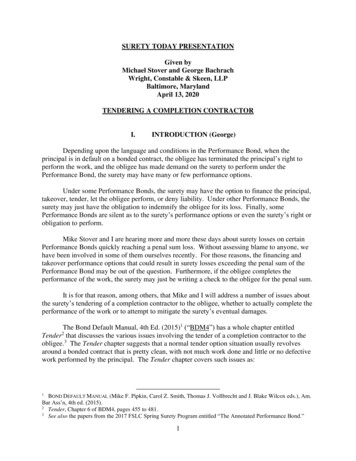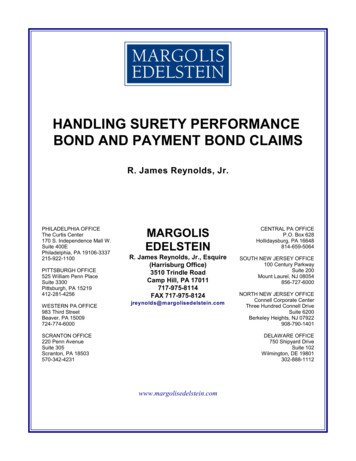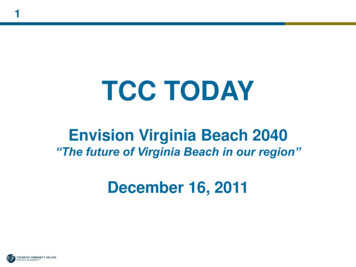
Transcription
SURETY TODAY PRESENTATIONGiven byMichael Stover and George BachrachWright, Constable & Skeen, LLPBaltimore, MarylandApril 13, 2020TENDERING A COMPLETION CONTRACTORI.INTRODUCTION (George)Depending upon the language and conditions in the Performance Bond, when theprincipal is in default on a bonded contract, the obligee has terminated the principal’s right toperform the work, and the obligee has made demand on the surety to perform under thePerformance Bond, the surety may have many or few performance options.Under some Performance Bonds, the surety may have the option to finance the principal,takeover, tender, let the obligee perform, or deny liability. Under other Performance Bonds, thesurety may just have the obligation to indemnify the obligee for its loss. Finally, somePerformance Bonds are silent as to the surety’s performance options or even the surety’s right orobligation to perform.Mike Stover and I are hearing more and more these days about surety losses on certainPerformance Bonds quickly reaching a penal sum loss. Without assessing blame to anyone, wehave been involved in some of them ourselves recently. For those reasons, the financing andtakeover performance options that could result in surety losses exceeding the penal sum of thePerformance Bond may be out of the question. Furthermore, if the obligee completes theperformance of the work, the surety may just be writing a check to the obligee for the penal sum.It is for that reason, among others, that Mike and I will address a number of issues aboutthe surety’s tendering of a completion contractor to the obligee, whether to actually complete theperformance of the work or to attempt to mitigate the surety’s eventual damages.The Bond Default Manual, 4th Ed. (2015)1 (“BDM4”) has a whole chapter entitledTender that discusses the various issues involving the tender of a completion contractor to theobligee.3 The Tender chapter suggests that a normal tender option situation usually revolvesaround a bonded contract that is pretty clean, with not much work done and little or no defectivework performed by the principal. The Tender chapter covers such issues as:21BOND DEFAULT MANUAL (Mike F. Pipkin, Carol Z. Smith, Thomas J. Vollbrecht and J. Blake Wilcox eds.), Am.Bar Ass’n, 4th ed. (2015).2Tender, Chapter 6 of BDM4, pages 455 to 481.3See also the papers from the 2017 FSLC Spring Surety Program entitled “The Annotated Performance Bond.”1
1.2.3.4.5.The surety’s right to tender under the Performance Bond;4The advantages and disadvantages of tender;5When tendering a completion contractor is appropriate;6Negotiations with the obligee;7 andOther factors to consider and the critical issues to address in any tender.8Mike and I can’t duplicate the chapter’s coverage and extent in 30 minutes. We willcover some of these issues and others based upon our own experiences, and will provide somecomments and suggestions for a surety to use tendering a completion contractor in some uniquesituations to mitigate the surety’s loss and damages.II.A.DISCUSSIONThe Surety’s Right/Ability To Tender (Mike)There is no statutory authority in the Miller Act that gives a surety the “right” to tender acompletion contractor and to my knowledge there is no such right in any of the Little Miller Actsacross the county. Nevertheless, tendering a completion contractor has always been a recognizedperformance option for sureties, albeit perhaps one of the more, less understood options by manyobligees.9 At its essence tendering a completion contractor is simply one of many methods forcuring the principal’s default by providing a replacement contractor and paying any costdifferential. In many instances, the surety’s “authority” for performing via a tender can be foundin the language of the performance bond itself. For example, the AIA A312 (2010) performancebond provides at Section 5.3 that the surety may:Obtain bids or negotiated proposals from qualified contractors acceptable to theOwner for a contract for performance and completion of the Construction Contract,arrange for a contract to be prepared for execution by the Owner and a contractorselected with the Owner’s concurrence, to be secured with performance andpayment bonds executed by a qualified surety equivalent to the bonds issued on theConstruction Contract, and pay to the Owner the amount of damages as describedin Section 7 in excess of the Balance of the Contract Price incurred by the Owneras a result of the Contractor Default;AIA A-312 (2010 ed.).Similar provisions permitting the surety to tender as its performance can be found in theAIA A311 Performance Bond, ConsensusDocs 260 (2011 ed.) Performance Bond at paragraph 24Tender, Chapter 6 of BDM4, pages 456 to 458.Tender, Chapter 6 of BDM4, pages 458 to 461.6Tender, Chapter 6 of BDM4, pages 461 to 474.7Tender, Chapter 6 of BDM4, pages 474 to 477.8Tender, Chapter 6 of BDM4, pages 477 to 481.9See Granite Computer Leasing Corp. v. Travelers Indem. Co., 894 F.2d 547, 551 (2d Cir. 1990); Aetna Cas. &Sur. Co. v. United States, 845 F.2d 971 (Fed. Cir. 1988); United States v. Seaboard Sur. Co., 817 F.2d 956, 959 (2dCir. 1987).52
(b); EJCDC form C-610 (2013 ed.) Performance Bond at paragraph 5.3.10 Courts have held thatdenying a surety its right under the AIA bond form generally to utilize the tender option or otheroptions in the bond can discharge the surety.11In Federal contracting, the Performance Bond, Standard Form 25 under the Miller Act,does not reference any surety performance options. However, the fact that the Miller Act andStandard Form 25 are silent about a tender option does not mean that a tender is prohibited. Onthe contrary, the Federal Acquisition Regulations (“FAR”), Section 49.4053, states that after thedefault of the contractor, and if the surety is not willing to takeover, the contracting officer mayarrange for the completion of the project by any appropriate contracting method or procedure.Which clearly gives the contracting officer sufficient authority to agree to a tender as the surety’sperformance. While there is not a lot of case law regarding tender in federal contracting, thereare a handful of cases where the court has at least recognized the surety’s and the government’stender arrangements.12While the tender option may be specifically addressed in a bond form, the option in thoseforms also typically requires some form of obligee consent. This can make matters somewhatmore challenging, because often, the obligee representatives are not familiar with the tenderconcept. This means that the surety will be required to do a good job of educating the obligeerepresentatives of the merits and benefits of tendering. The authors of the Tender chapter in theBDM4 have done a good job of laying out the benefits of choosing the tender option and you canrefer to that discussion when you are trying to convince an obligee of the merits of a tender. Theauthors observed that “tender agreements with obligees are generally the product of skillfulnegotiation and thoughtful analysis.”B.Specific Issues In The Tender ProcessAs with any of the surety’s performance options, before the surety goes down the “tenderroad” with an obligee after a principal’s termination, the surety must obtain some criticalinformation concerning the bonded contract such as: the remaining scope of work, the status ofthe bonded contract funds, and the time of completion.1.“Time of Completion”The time of completion can often be a point of contention and will need to be negotiatedand addressed in any Tender Agreement. Typically, the completion contractor will provide anestimate of time that it believes it will take to complete the remaining scope of work and that willNat’l Fire Ins. Co. of Hartford v. Fortune Constr. Co., 320 F.3d 1260 (11th Cir. 2003) (holding that the languageof an AIA A311-based subcontractor bond was broad enough to include a tender option).11St. Paul Fire & Marine Ins. Co. v. City of Green River, Wyo., 6 F. App’x 828, 829 (10th Cir. 2001)(the courtheld that the surety was discharged under its bond when the obligee prohibited the surety from exercising itscontractual right to perform or to participate in the selection of the completion contractor.); see also St. Paul Fire &Marine Ins. Co. v. VDE Corp., 603 F. 3d 119, 123–125 (1st Cir. 2010).12Hanover Ins. Co. v. U.S., 116 Fed. Ct. 303, 305 (2014); Wagner v. U.S., 71 Fed. Cl. 355, 358 (2006); Aptus Co.v. U.S., No. 05-106C, 2005 WL 6112638 at *1 (Fed. Ct. June 27, 2005); Appeals of L&M Thomas Concrete Co.,Inc., ASBCA No. 49198, 98-1 B.C.A. (CCH) ¶29560 (Feb. 2, 1998); Exec. Const., Inc., GSBCA No. 15224, 00-2B.C.A. (CCH) ¶30977 (June 9, 2000).103
be used as the new completion date in the Tender Agreement. Usually, the new completion datewill be further out than the original scheduled completion date. This delta can give rise to apotential claim for liquidated damages. In addition, in some cases, the principal may have beenbehind schedule at the time of the default and LD’s may have already been incurred when thesurety gets on the scene.Many times the obligee will readily agree to waive liquidated damages or other delaycosts in exchange for the surety’s agreement to tender. Other times, LD’s can become a stickingpoint that must be negotiated. In some instances, the obligee will say things like they “don’thave the authority to waive LD’s” or they “will need to go to a higher authority to get LD’swaived.” The surety’s response that often works the best is to point out that LD’s don’t need tobe waived; all the obligee needs to do is grant a non-compensatory time extension. A timeextension will have the effect of erasing the “delay” and any LD’s associated with it. Mostobligees have the authority at the project level to adjust the schedule and recognize “excusable”delay. If there needs to be a fight over LD’s, I recommend that you check out our prior SuretyToday episode on Liquidated Damages, which was presented on August 13, 2018, for adiscussion of the various defenses that can be asserted to eliminate or mitigate LD’s.2.“Remaining Contract Funds”Typically, the principal will have performed some portion of the underlying contract andwill have been paid some portion of the contract funds prior to its termination. Accordingly, inthe tender process the surety will need to determine what the remaining contract funds are for theproject. The amount of remaining funds are critical, because that amount is ultimately used todetermine the excess costs of completion and the amount the surety will have to pay as part ofthe tender.The contract balance is generally a function of calculating the present amount of thecontract (the original contract price plus or minus the value of any approved change orders ormodifications), less the obligee’s payments already made to the principal. You would think thatdetermining the remaining contract balance would be simple and straight forward, butsometimes, especially when dealing with a general contractor as the obligee, it can become anissue. For example, the obligee may claim deductions from the contract balance forbackcharges, supplementation, the ubiquitous “clean up” charges, deductive or unilateral changeorders, etc. On the other hand, the principal may be contending that it has extra work,unapproved change orders or claims that should be part of the contract balance. These issueswill all need to be sorted out in the negotiation process to determine the amount of remainingfunds. I had a case recently, where we were getting ready to sign an Agreement with an obligeewhen the obligee added a provision regarding some water damage sustained. No informationhad been provided on these alleged damages. Ultimately, the obligee provided information on 250,000 in alleged damages, which was more than the remaining contract funds. Obviously,that brought the process to a grinding halt while we investigated these alleged damages.4
3.“Scope of Work”Determining the remaining scope of work is essential in the tender process. The obligee,the surety, the surety’s consultant and the eventual completion contractor may encounter themost disputes surrounding this issue. I will address the scope of work issue from the obligee andsurety perspective, and George will later address this issue from the surety and completioncontractor perspective.Because the surety will be seeking a release from the obligee of any further obligationsunder the Performance Bond as part of the tender process, the obligee will want to know thatALL of the remaining scope of work under the contract will be performed. From the obligee’sperspective this is where the risk in a tender arrangement resides. To examine what theremaining scope of work is, we will analyze it in four broad “buckets.”(a)First Bucket - The remaining unperformed work that is described in theunderlying contract, including the approved submittals, addenda, and approved change ordersand modifications. In its analysis, the surety should attempt to have the obligee affirm that thework performed to date has met the contract requirements, or if there are any known issues tospecifically identify those issues. We just had a project where the principal had been on the jobfor over a year and over half of the contract funds had been paid out. We assembled a bunch ofpotential completion contractors and we went to the project site with a representative of theobligee to view the site and when one of the prospective bidders asked what percentage of thework had been approved, the obligee representative said “none.” After that, many of the biddersrefused to bid and others inflated their bids. That necessitated a lengthy letter from me to theobligee advising among other things that if over half of the contract funds had been paid out andnone of the work was approved, the obligee had seriously overpaid and impaired the surety’srights. Subsequently, the obligee approved the majority of the work and we got new bids.(b)Second Bucket - Patently defective work of the principal that must becorrected by any completion contractor. This work will be part of the remaining work to beperformed, regardless of whether the obligee has already paid for that poorly performed work.(c)Third Bucket - Latent defective work performed by the principal –unknown at the time of the principal’s termination and during the negotiations between theobligee and the surety. Because by definition latent defects are “unknown” this category canprovide the most concern to an obligee, particularly in light of the release to be given to thesurety as part of the Tender Agreement. There are a number of ways to address this issue. First,as George will discuss, it can be handled through agreement with the completion contractor.Second, the surety and obligee can negotiate a set price for the risk to be paid as part of thetender. Third, the surety and obligee can carve the latent defects out of the release in the TenderAgreement and add provisions to the Agreement to address latent defects as they arise postTender.(d)Fourth Bucket - Warranty work that may subsequently have to beperformed within the bonded contract’s warranty periods.5
The scope of work issues can be a complicating factor in any tender and is one of thereasons why many “experts” contend that the tender option is not suited for projects where thework has progressed too far along and there are many unknowns. Nevertheless, there are anumber of reasons that we will discuss today why a tender may work to mitigate the surety’s lossnotwithstanding the high percentage of completion of the work when the principal is terminated.C.Potential Obligee Impediment To A TenderOne of the more common potential “obligee impediments” that sureties may encounterwhen tendering to a governmental obligee is the misbelief that the obligee must comply withpublic competitive bidding requirements before it can execute a direct contract with thecompletion contractor tendered to it by the surety. The surety’s response to this impediment isthat the contract was already publicly bid out once and awarded to the surety’s now terminatedprincipal; the surety is paying the price increase difference due to the completion contractor’sprice, and the public owner does not shell out any additional public funds. Further, undergeneral suretyship law sureties are afforded the opportunity to perform under the performancebond and tendering is constitutes that performance and it is therefore not a new procurement andnot subject to the competitive bidding requirements. Finally, even public owners have anobligation to mitigate damages and accepting the tender in most circumstances would beconsidered mitigation of damages.Arguments such as this leads to one of the fundamental requirements when considering atender option – always be upfront with the obligee right from the beginning that the surety isconsidering a tender of a completion contractor. This includes explaining exactly what a tenderis, the documents involved, and what the surety is looking for in a tender, including a release ofits Performance Bond. Be sure that the decision makers, not just the obligee’s field people,understand what a tender is and how it works, and confirm this in writing. Getting the issues outin the open up front can help to avoid a lot of lost time and lost expenditures. It can also serve toflush out a lot of other issues in a timely fashion that will give the parties more time to addressthem and find solutions.D. Completion Contractor Considerations In A Tender (George)1.Bidding And/Or Negotiating The Scope Of Work Issues.While the obligee’s main concern is to have the tendered completion contractor timelyperform and complete the remaining scope of work on the project, the completion contractor hastwo main concerns – first, defining the scope of work to be performed in order to then, second,price that work for its bid to the surety and/or negotiation of a contract with the obligee. Thecompletion contractor can’t price the work or determine its time of completion until it knows thescope of work to be performed.Just as the obligee wants to have all of the work required in the original contract with theprincipal performed and completed, the completion contractor, who will be contracting with theobligee to do that scope of work, will want to know what that work is so it can be quantified andagreed to as it relates directly to both the completion contractor’s price to do the work and the6
time of completion of the work. The factors of scope of work, price and time are interrelated,but an accurate definition of the scope of the work is the critical starting point.13If there is sufficient time, the usual process for obtaining a completion contractor is to bidthe work using a full bid package, or Invitation to Bid, that provides the bidders with all of theinformation and documentation they need – the original contract, plans, specifications, addendato the contract, approved submittals, any obligee responses to requests for information, and otherdocumentation – to bid the project as it now stands, partially completed by the principal. Even ifthe project is not bid out, but negotiated instead among the surety, the obligee and the completioncontractor, the same information and documentation is required.The completion contractor has to look at the same four buckets of work to perform thatMike has listed as part of the obligee’s concerns. Identifying and completing the unperformedwork that remains after the principal is terminated from the project is one thing – it may becomplex, but it can be accomplished. The same is true for any known patently defective work ofthe principal that can be readily ascertained for purposes of correction and pricing.What is much more difficult for the completion contractor to determine is possible latentdefective work – the electrical outlets are in place, the drywall has been installed, but the wires tothe electrical outlets have n
Apr 13, 2020 · For example, the AIA A312 (2010) performance bond provides at Section 5.3 that the surety may: Obtain bids or negotiated proposals from qualified contractors acceptable to the Owner for a contract for performance and completion of the Construction Contract, arrange for a contract to be











